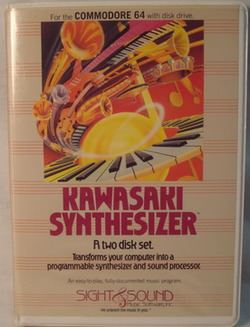Initial release date 1983 Mode Single-player video game | Release date(s) 1983 | |
 | ||
Publisher(s) Sight & Sound Music Software, Inc. Genres Music video game, Non-game | ||
Ryo kawasaki 1984 kawasaki synthesizer demo c64
The Kawasaki Synthesizer is a musical software tool for the Commodore 64 created in 1983 by Japanese jazz musician, Ryo Kawasaki. The first of four music programs created by Kawasaki, Kawasaki Synthesizer was followed by Kawasaki Rhythm Rocker in 1985, and then Kawasaki Magical Musiquill in 1985. Following this Kawasaki created Kawasaki MIDI Workstation his only software title intended for professional use instead of personal or educational use.
Contents
- Ryo kawasaki 1984 kawasaki synthesizer demo c64
- Development history
- Usage
- Kawasaki Rhythm Rocker
- Kawasaki Magical Musiquill
- Kawasaki MIDI Workstation
- References
Development history
As soon as the Commodore 64 was released in 1982, Kawasaki immediately bought one, paying $600 for it at an electronics store on 45th street in Manhattan. Kawasaki was fascinated by the possibilities the system afforded him and in two years he taught himself to program and wrote four programs in machine code using SuperMon (a tool created by Jim Butterfield) that he released commercially on 5¼-inch floppy for $49.95 each as well as an unpublished 8-track real-time MIDI recorder called Midi-Workstation.
Usage
The Kawasaki Synthesizer was sold as a 2-disk package that according to its own demonstration "will transform [a] Commodore 64 into an incredible synthesizer and more." The program came with a software version of a techno track by Kawasaki entitled "Satellite Station," and it allowed a user to select notes to be played and create songs that could then be saved. Numerous other typically Kawasakian influences were also notably discernible, including the Kawasaki Space Theatre which depicted a couple of Thai kick boxers who would fly by. The program was regarded as having a dream-like fairy-tale atmosphere, and as future programs were released the color schemes (for example in Kawasaki Magical Musiquill) became increasingly psychedelic.
Different modes were available including the "Easy Beginner Version" (in which a new player could learn how to create music in simple steps), "Demo" (in which the player was shown a pre-recorded display created by Kawasaki that highlighted the capabilities of the program), and "The Performer" - the composition portion of the program.
Kawasaki Rhythm Rocker
Kawasaki Rhythm Rocker was noted to be considerably different from Kawasaki Synthesizer despite the fact that it used a similar keyboard input and was designed to allow the player to create music in a synthesizer style. The program depicted space imagery, a theme that would become common throughout Kawasaki's programs. Kawasaki Rhythm Rocker allowed the player to alter tempo, dub, and bass, and to record his compositions.
Kawasaki Magical Musiquill
The most colorful of Kawasaki's applications, Kawasaki Magical Musiquill was the last program Kawasaki designed as a non-game for children, with his next release, Kawasaki MIDI Workstation, designed as a serious work for professional studio use.
Kawasaki MIDI Workstation
Developed in 1986, Kawasaki MIDI Workstation was Kawasaki's only work of professional software, and after finishing this program he founded Satellites Records and returned to making music of his own.
